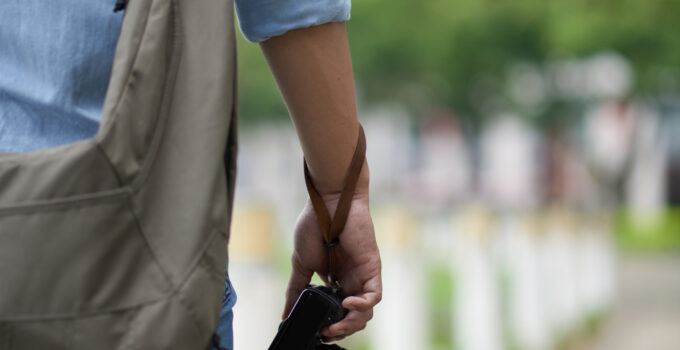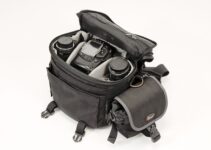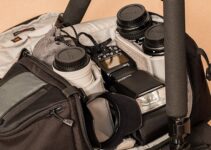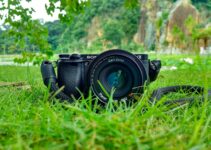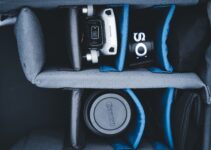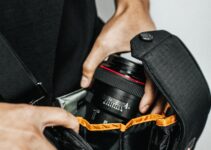Do you love to take photos on your bike rides, but struggle to find the right bag to keep your camera safe and secure? Look no further! In this article, we’ll explore the best options for bike camera bags and help you choose the one that’s right for you.
When it comes to a bike camera bag, you need something that’s durable, weather-resistant, and easy to access.
After researching and testing various options, we’ve found that a handlebar bag or a top tube bag works best for most riders. These bags provide easy access to your camera while keeping it safe from bumps and jolts.
But these are just the tip of the iceberg. In this article, we’ll dive deeper into the world of bike camera bags, exploring different sizes, materials, and features to help you find the perfect fit for your camera and your riding style.
So, whether you’re a casual rider or a professional photographer, let’s find the perfect bike camera bag for you!
How to Carry Camera Gear on a Bike?
Carrying camera gear on a bike requires a few considerations to ensure that your equipment is safe and secure during the ride. Here are some tips on how to carry camera gear on a bike:
1. Choose the right bag:
The first step is to choose a bag that is designed specifically for carrying camera gear on a bike. There are many options available, including backpacks, handlebar bags, and panniers. Look for a bag that is waterproof and has padding to protect your equipment.
2. Pack your gear carefully:
Once you have chosen the right bag, it’s important to pack your gear carefully to prevent damage during transport. Use padded inserts or dividers to keep your camera, lenses, and other accessories in place and protect them from bumps and jostling.
3. Balance your load:
When carrying camera gear on a bike, it’s important to distribute the weight evenly to avoid throwing off your balance. Make sure your bag is secured to the bike and adjust the straps and buckles to keep the weight centered.
4. Consider your route:
Before you set out, consider the terrain you will be riding on and adjust your gear accordingly. For example, if you will be riding on rough terrain, you may want to choose a bag with more padding or opt for a backpack instead of a handlebar bag.
5. Secure your gear:
Finally, make sure your gear is securely fastened to the bike to prevent it from shifting or falling off during the ride. Use straps, bungee cords, or other fasteners to keep your bag in place.
By following these tips, you can safely and securely carry your camera gear on a bike, allowing you to capture great photos and videos while enjoying a fun ride.
Let’s move to some best ways to a carry a camera on your bike.
Best ways to a carry a camera on your bike
Here take a look at 10 best ways to a carry a camera on your bike.
1) Forget the full frame DSLR and 24-70 and 70-200 F2.8 lenses.
The point of “forgetting the full frame DSLR and 24-70 and 70-200 F2.8 lenses” when carrying a camera on a bike is to consider using a lighter and more compact camera system.

Full frame DSLR cameras and their accompanying lenses can be quite heavy and bulky, which can make them difficult to carry on a bike. Instead, consider using a mirrorless camera system, which tends to be smaller and lighter while still offering excellent image quality.
In terms of lenses, the 24-70mm and 70-200mm f/2.8 lenses are popular choices among professional photographers due to their versatility and fast maximum aperture. However, they are also quite heavy and can be challenging to carry on a bike.
Consider using smaller and lighter lenses, such as prime lenses or zoom lenses with a smaller maximum aperture. These lenses can still produce great results while being easier to carry on a bike.
Ultimately, the point is to prioritize portability and convenience when choosing your camera and lenses for bike photography.
2) Handlebar bag – Ortlieb Ultimate 6
The second point, “Handlebar bag – Ortlieb Ultimate 6,” refers to a specific type of bag that is designed to be mounted on the handlebars of a bike. The Ortlieb Ultimate 6 is a popular brand of handlebar bag among cyclists and photographers.
A handlebar bag is a convenient option for carrying a camera on a bike because it allows you to keep your camera easily accessible while riding. You can quickly and easily access your camera to capture photos without having to stop and unpack your gear.
The Ortlieb Ultimate 6 is a high-quality handlebar bag that is designed to be waterproof and durable, making it ideal for use in all types of weather conditions. It features a clear window that allows you to see and control your camera while it is still inside the bag.
Additionally, the Ortlieb Ultimate 6 has a padded interior that provides protection for your camera and other gear. It also has a removable shoulder strap, which makes it easy to carry your bag and camera off the bike.
Overall, a handlebar bag like the Ortlieb Ultimate 6 is a great option for carrying your camera on a bike because it keeps your gear easily accessible and protected from the elements while you ride.
4) Frame bags, saddle bags, panniers, fork bags
The fourth point, “Frame bags, saddle bags, panniers, fork bags,” refers to different types of bags and storage options that can be used to carry camera gear on a bike.
Frame bags are designed to fit within the frame of the bike and can be a good option for carrying smaller camera equipment or accessories. They can be placed on the top tube, seat tube or downtube of the frame.
Saddle bags are larger bags that attach to the back of the saddle and seat post, and they can be used to carry larger camera gear or other items. They are often waterproof and durable, making them a good option for use in all types of weather conditions.
Panniers are bags that attach to racks on the front or rear of the bike, and they are typically larger and designed for carrying heavier loads. They can be used to carry larger camera gear or other items that may not fit in smaller bags.
Fork bags are smaller bags that attach to the front fork of the bike, and they can be a good option for carrying small items such as a camera lens or accessories.
Overall, the different types of bags and storage options offer a range of choices for carrying camera gear on a bike. It is important to choose the right size and type of bag for your specific camera equipment and riding needs.
5) Shoulder sling bag – Thinktank Turnstyle V2 5L
The fifth point, “Shoulder sling bag – Thinktank Turnstyle V2 5L,” refers to a specific type of bag that is designed to be worn over the shoulder, with a strap that goes diagonally across the body.
The Thinktank Turnstyle V2 5L is a popular brand of shoulder sling bag among photographers who want to carry their camera gear on a bike.
A shoulder sling bag is a convenient option for carrying camera gear on a bike because it allows you to easily carry your gear off the bike while keeping your hands free for riding.
The Thinktank Turnstyle V2 5L is a compact and lightweight bag that is designed to hold a camera and a few lenses, making it a good option for photographers who want to travel light.
The bag features a padded interior that provides protection for your camera and lenses, as well as a customizable interior divider system that allows you to organize your gear. It also has a front pocket that can hold accessories such as memory cards or filters.
The Thinktank Turnstyle V2 5L is designed with a breathable mesh back panel and a padded shoulder strap that is adjustable for a comfortable fit. It also has a stabilizing strap that can be attached to the bike frame to keep the bag from swinging while riding.
Overall, a shoulder sling bag like the Thinktank Turnstyle V2 5L is a good option for carrying camera gear on a bike because it allows you to easily carry your gear off the bike while keeping your hands free for riding. It is also a compact and lightweight solution that can be used in conjunction with other bags or storage options.
6) Shoulder / waist sling – Peak Design Everyday Sling 3, 5, 6L
The sixth point, “Shoulder/waist sling – Peak Design Everyday Sling 3, 5, 6L,” refers to a type of bag that can be worn over the shoulder or around the waist.
The Peak Design Everyday Sling is a popular brand of shoulder/waist sling bag among photographers who want to carry their camera gear on a bike.
A shoulder/waist sling bag is a versatile option for carrying camera gear on a bike because it can be worn in different ways to suit your needs.
The Peak Design Everyday Sling comes in three sizes – 3L, 5L, and 6L – and is designed to hold a camera and a few lenses, as well as other accessories such as a phone or wallet.
The bag features a padded interior that provides protection for your camera and lenses, as well as a customizable interior divider system that allows you to organize your gear. It also has multiple pockets and compartments for accessories such as memory cards, batteries, or filters.
The Peak Design Everyday Sling is designed with a breathable mesh back panel and a padded strap that can be adjusted for a comfortable fit. It also has a stabilizing strap that can be attached to the bike frame to keep the bag from swinging while riding.
Overall, a shoulder/waist sling bag like the Peak Design Everyday Sling is a versatile option for carrying camera gear on a bike.
It can be worn in different ways to suit your needs and can hold a variety of camera equipment and accessories. It is also a compact and lightweight solution that can be used in conjunction with other bags or storage options.
7) Backpacks
The seventh point, “Backpacks,” refers to a type of bag that is worn on the back and is a common way for photographers to carry their camera gear on a bike.
A backpack provides a larger capacity than other bags and is designed to distribute the weight of the gear evenly across the back, making it a comfortable option for longer rides.
Backpacks designed for carrying camera gear often feature padded compartments and dividers that provide protection and organization for the gear.
They also typically have additional pockets and compartments for storing accessories such as memory cards, batteries, or filters.
When using a backpack to carry camera gear on a bike, it’s important to choose one that is designed specifically for this purpose.
Look for a backpack with a ventilated back panel that allows air to flow through and keep you cool, and adjustable straps that allow you to customize the fit.
It’s also important to consider the weight of the backpack and how it will affect your riding. A heavier backpack can cause strain on your back and shoulders, so it’s important to choose a backpack that is appropriate for the amount of gear you need to carry.
8) GoPro action camera chest or shoulder harness
The best way would be, “GoPro action camera chest or shoulder harness,” refers to a specific type of camera accessory that is designed to hold an action camera, such as a GoPro, on the rider’s chest or shoulder.
A chest harness is designed to hold the camera on the rider’s chest, while a shoulder harness is designed to hold the camera on the rider’s shoulder. Both types of harnesses provide a stable and secure way to capture footage while riding a bike.
GoPro action camera harnesses are lightweight, compact, and easy to use. They are designed to hold the camera securely in place while riding, even on bumpy terrain. The harnesses typically feature adjustable straps that allow you to customize the fit, and they are often made from breathable and sweat-resistant materials.
Using a GoPro action camera harness to carry your camera on a bike allows you to capture footage from a unique perspective, such as the rider’s point of view. This can be especially useful for action-packed rides or for capturing footage of beautiful scenery while cycling.
Overall, a GoPro action camera chest or shoulder harness is a convenient and secure option for carrying a camera on a bike. They are lightweight, easy to use, and provide a unique perspective for capturing footage while cycling.
9) Camera Straps
The ninth way to carry a camera on your bike is by using a camera strap. Camera straps are designed to be worn around the neck, shoulder, or wrist, and are a simple and convenient way to keep your camera accessible while riding.

Camera straps come in various styles, materials, and designs, and can be adjusted to fit your preferences and comfort level. Some camera straps are designed to be padded, making them more comfortable to wear for extended periods, while others are made from durable materials that can withstand outdoor use.
One of the advantages of using a camera strap to carry your camera on a bike is that it keeps the camera within easy reach, allowing you to quickly capture shots while riding. However, it’s important to make sure that the camera is securely attached to the strap and that the strap is comfortable to wear while riding.
Additionally, camera straps may not be the best option for carrying larger cameras or multiple lenses, as the weight can cause discomfort or strain on the neck and shoulders.
Overall, a camera strap is a simple and convenient option for carrying a camera on a bike, especially for those who want to keep the camera within easy reach while riding. However, it’s important to consider the weight and size of the camera and to make sure that the strap is comfortable and secure before using it on a ride.
10 ) Change your camera? – jersey pocket
The tenth way to carry a camera on your bike is to simply change your camera to a smaller, more compact option that can easily fit into a jersey pocket.
This option is ideal for riders who prioritize speed and efficiency, as it allows you to easily access your camera without having to stop and unpack a bag or strap. It’s also a good option for riders who don’t need to carry multiple lenses or bulky equipment.
Smaller cameras, such as point-and-shoot or mirrorless cameras, can easily fit into a jersey pocket and are often more lightweight and compact than larger DSLR cameras.
However, it’s important to make sure that the camera is securely stored in the pocket to prevent damage or loss while riding.
One of the advantages of carrying your camera in a jersey pocket is that it allows you to quickly and easily capture shots while on the go. However, it’s important to keep in mind that the camera may not be as well-protected as it would be in a dedicated camera bag or case.
Overall, changing your camera to a smaller, more compact option that can easily fit into a jersey pocket is a simple and convenient way to carry a camera on a bike.
However, it’s important to make sure that the camera is securely stored and protected while riding to prevent damage or loss.
As you have seen theses are the best ways to carry your camera bag. Now look up at some best camera bag or mountain biking.
Best Camera Bag for Mountain Biking
1. Trunk Bag
A trunk bag is a type of camera bag that is designed to be mounted on the rear rack of a bike, making it a popular option for mountain bikers who want to carry their camera gear on longer rides.
Trunk bags typically have a large main compartment and several smaller pockets or compartments for organizing camera equipment, as well as other essentials like snacks, tools, and spare parts.
They are often made from durable materials that can withstand outdoor use and come with straps or attachment points that allow you to securely mount the bag to the bike’s rear rack.
One of the advantages of using a trunk bag to carry your camera gear on a mountain bike ride is that it provides easy access to your equipment without interfering with your riding.
The bag is located on the rear rack of the bike, which means that it is out of the way while you ride but still within easy reach when you need to take a photo.
Another advantage of using a trunk bag is that it distributes the weight of your camera gear evenly across the bike, making it more comfortable to ride for longer periods.
This is especially important for mountain bikers who may need to carry heavier equipment or ride on challenging terrain.
Overall, a trunk bag is an excellent option for mountain bikers who want to carry their camera gear on longer rides. It provides ample storage space, easy access to equipment, and even weight distribution, making it a comfortable and convenient choice for photographers on the go.
2. Handlebar Bag
A handlebar bag is a type of camera bag that is designed to be mounted on the handlebars of a bike. It’s a popular option for mountain bikers who want to keep their camera gear close at hand while they ride.
Handlebar bags come in different sizes and styles, but most have a main compartment for storing camera equipment and other essentials like a phone, wallet, and snacks. Some also have additional pockets or compartments for organizing smaller items.
One of the advantages of using a handlebar bag to carry your camera gear on a mountain bike ride is that it provides easy access to your equipment while you ride.
The bag is located on the handlebars, which means that you can quickly grab your camera and take a photo without having to stop or remove the bag from the bike.
Another advantage of using a handlebar bag is that it helps distribute the weight of your camera gear across the bike. This can make it more comfortable to ride for longer periods, especially if you’re carrying heavier equipment or riding on challenging terrain.
However, one potential downside of using a handlebar bag is that it can interfere with your riding if it’s too bulky or if the weight distribution isn’t balanced properly.
It can also be difficult to attach and remove the bag from the handlebars, especially if you need to do it frequently.
3. Small Pouches
Small pouches are a compact and convenient way to carry camera equipment while mountain biking. These pouches can be attached to various parts of the bike, such as the handlebars, saddle, or frame, using straps or clips.
One of the advantages of using small pouches is their versatility. They can be customized to fit the specific needs of the rider, allowing them to carry only the equipment that’s essential for their ride.
For example, a rider may choose to use a small pouch to carry just their camera and a spare battery, while another rider may use multiple pouches to carry a camera, lenses, and other accessories.
Another advantage of using small pouches is that they’re typically lightweight and don’t add significant bulk to the bike. This can be particularly important for mountain bikers who need to move quickly and maneuver their bike over challenging terrain.
However, one potential downside of using small pouches is that they may not provide as much protection for camera equipment as other types of camera bags. Pouches that are attached to the outside of the bike may be more susceptible to damage from rocks, branches, or other obstacles on the trail.
Overall, small pouches are a good option for mountain bikers who want to carry a small amount of camera equipment and don’t need the extra protection of a larger camera bag.
They’re versatile and lightweight, but it’s important to make sure that they’re securely attached to the bike and that any valuable equipment is protected from potential damage.
4. Shoulder-strap bags
Shoulder-strap camera bags are a popular choice for mountain bikers who want to carry their camera equipment on their person.
These bags typically feature a single strap that can be worn across the body or over one shoulder, leaving the hands free for riding.
One advantage of using a shoulder-strap bag is that it provides easy access to camera equipment while on the go. The bag can be quickly swung around to the front of the body, allowing the rider to quickly grab their camera and take a shot without stopping.

Outdoor portrait of excited girl wears trendy broad-brim and standing in confident pose. Attractive young woman in glasses posing on autumn nature background.
Another advantage is that shoulder-strap bags are typically designed with a range of pockets and compartments, allowing the rider to organize their equipment and accessories as needed.
This can be particularly important for mountain bikers who need to carry multiple lenses or other accessories.
However, one potential disadvantage of using a shoulder-strap bag is that it may not provide as much protection for camera equipment as other types of camera bags.
The bag is in close proximity to the rider’s body, which may not be sufficient to protect the equipment from damage in the event of a fall.
Overall, shoulder-strap camera bags are a good option for mountain bikers who want easy access to their camera equipment and prefer to carry it on their person.
However, it’s important to make sure that the bag is securely fastened and that any valuable equipment is protected from potential damage.
5. Sling straps
Sling straps are another popular option for mountain bikers who want to carry their camera equipment on their person while riding.
These straps typically feature a single diagonal strap that can be worn across the body, with the camera equipment resting on the user’s hip or back.
One advantage of using a sling strap is that it allows the rider to quickly and easily access their camera equipment without having to stop and remove a backpack or other type of camera bag.
This can be particularly important for mountain bikers who want to capture action shots while on the move.
Another advantage is that sling straps are typically lightweight and compact, making them easy to carry and ideal for use on shorter rides or when minimal equipment is needed.
However, as with shoulder-strap bags, one potential disadvantage of using a sling strap is that it may not provide as much protection for camera equipment as other types of camera bags.
It’s important to make sure that the equipment is securely fastened and that any valuable items are protected from potential damage.
Overall, sling straps are a good option for mountain bikers who want a lightweight and compact way to carry their camera equipment on shorter rides or for capturing action shots on the go.
Backpack mount
A backpack mount is a specialized camera bag that can be attached directly to a backpack or hydration pack that a mountain biker might wear while riding.
The camera equipment is typically stored in a padded compartment within the backpack mount, which is then securely fastened to the backpack using straps or other attachments.
One advantage of using a backpack mount is that it allows the rider to keep their camera equipment close at hand without having to wear an additional bag or carry the equipment separately.
This can be particularly convenient for longer rides or multi-day trips, as it allows the rider to easily access their equipment without having to stop and remove a separate camera bag.
Another advantage is that a backpack mount can provide more protection for camera equipment than other types of camera bags, as it is typically designed to withstand the rigors of mountain biking and is made from durable materials that can withstand impacts and moisture.
However, a potential disadvantage of using a backpack mount is that it may not be as comfortable or convenient to use as other types of camera bags, particularly if the rider is carrying a lot of other gear in their backpack.
Additionally, it may not be as easily accessible for quickly grabbing equipment while riding, as it may require removing the backpack from the rider’s back to access the camera equipment.
Overall, a backpack mount can be a good option for mountain bikers who want a convenient and protective way to carry their camera equipment while riding.
However, it’s important to consider the potential drawbacks and to choose a backpack mount that is compatible with the rider’s backpack and camera equipment.
Best Bike Handler Camera Bag
When it comes to carrying camera gear on a bike, there are a few different types of bags that can be suitable for different purposes. Here are some options for the best bike handler camera bags:
1. Handlebar Bag:
A handlebar bag, such as the Ortlieb Ultimate 6, can be a great option for carrying a camera while riding. These bags attach to the handlebars of the bike and provide easy access to gear while riding. They typically have a waterproof or water-resistant design and come in a variety of sizes.
2. Saddlebag:
A saddlebag can also be a good option for carrying camera gear on a bike. These bags attach to the underside of the saddle and typically have a compact design that is ideal for storing smaller items like a camera and lenses. Look for a saddlebag with a secure closure and durable construction, such as the Topeak Aero Wedge Pack.
3. Backpack:
For riders who prefer to carry their gear on their back, a backpack can be a good choice. Look for a backpack with a padded compartment specifically designed for camera equipment, such as the Lowepro PhotoSport Backpack. This type of backpack will provide the necessary protection for your gear while also allowing you to carry other essentials like water and snacks.
4. Handlebar Bottle Bag:
A handlebar bottle bag, like the Revelate Designs Mountain Feedbag, can be a convenient way to carry a camera while also providing easy access to water or other essentials. These bags attach to the handlebars and are designed to hold a water bottle or other small items.
5. Frame Bag:
A frame bag is a type of bag that attaches to the frame of the bike and provides additional storage space. Look for a frame bag with a padded compartment for camera gear, such as the Blackburn Outpost Elite Frame Bag.
This type of bag can be a good option for riders who want to carry more gear on their bike but don’t want to wear a backpack or other bag.
Ultimately, the best bike handler camera bag will depend on your individual needs and preferences. Consider the type of riding you will be doing, the amount of gear you need to carry, and your personal preferences for accessing and carrying your gear while riding.
Related faq’s
How do you carry a camera while riding a bike?
There are several ways to carry a camera while riding a bike, depending on the type of camera and the level of protection you need. Some common ways include:
- Forget the full frame DSLR and heavy lenses and opt for a smaller, more compact camera that can fit into a handlebar bag, saddlebag, or backpack.
- Use a handlebar bag, such as the Ortlieb Ultimate 6, which is a waterproof bag that attaches to your handlebars and can hold your camera and other small items.
- Consider a handlebar bottle bag, like the Revelate Designs Mountain Feedbag, which can hold a small camera or other items you need quick access to.
- Use frame bags, saddle bags, panniers, fork bags, or other types of bags that attach to your bike frame and can hold your camera and other gear.
- Consider a shoulder sling bag, such as the Thinktank Turnstyle V2 5L, which can be worn across your body and can hold your camera and a few other essentials.
- Use a shoulder or waist sling, like the Peak Design Everyday Sling 3, 5, 6L, which can be worn over your shoulder or around your waist and can hold your camera and other small items.
- Use a backpack, like the Osprey Raptor 10, which is designed specifically for mountain biking and can hold your camera, water, and other essentials.
- Consider a GoPro action camera chest or shoulder harness, which can securely hold your camera while you ride.
- Use a camera strap, like the BlackRapid Sport Breathe, which can attach to your camera and allow you to wear it securely across your body while you ride.
- If you have a small, lightweight camera, you can also consider putting it in your jersey pocket, although this is not recommended for heavier cameras or for rough terrain.
Conclusion:
In conclusion, there are several options available for carrying a camera while riding a bike, depending on personal preference and the specific needs of the photographer.
The type of camera, the terrain, and the duration of the ride all play a role in determining the ideal camera bag. Some popular options include handlebar bags, trunk bags, small pouches, shoulder-strap bags, sling straps, and backpack mounts.
Each option has its own advantages and disadvantages, so it’s important to carefully consider one’s needs and budget before making a purchase.
Ultimately, a bike camera bag should provide a secure and accessible storage solution that allows for easy access to the camera while on the go.

